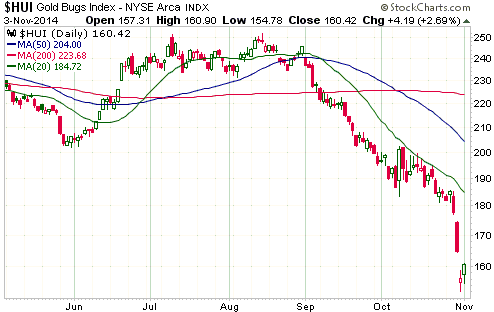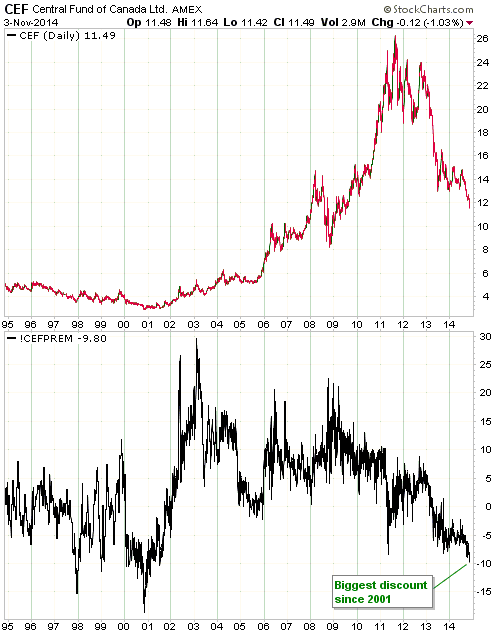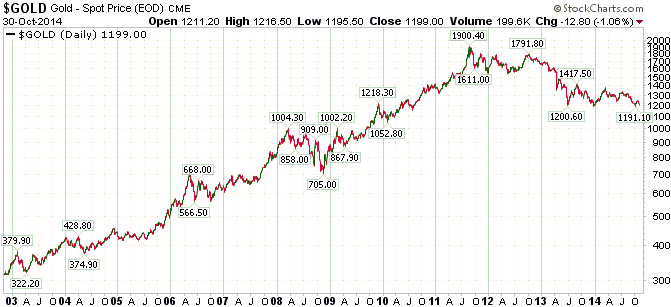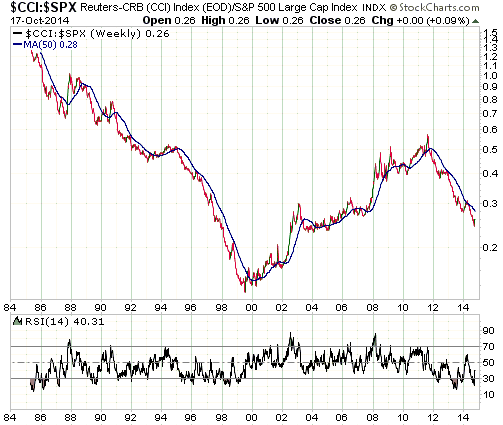I start reading a lot more articles about gold than I finish reading. This is because as soon as I read something in an article that reveals a very basic misunderstanding about the gold market, I stop reading. Sometimes I don’t even get past the first paragraph. Life is too short and there is so much to read that I refuse to waste time reading the words of someone who has just demonstrated cluelessness on the topic at hand. Here are some of the ‘red flag’ statements and arguments in a gold-related article that would stop me in my tracks.
1) Treating annual gold mine production as if it were a large part of the supply side of the equation.
In other metals markets it can make sense to treat new mine supply as if it were a proxy for total supply, but in the gold market the mining industry’s annual production is roughly equivalent to only 1.5% of total supply (see my earlier post on this topic). Therefore, as soon as an article starts comparing the amount of gold bought by a country or market segment with the mining industry’s annual production, as if the mining industry’s production was the main way in which gold demand could be satisfied, I stop reading.
2) Misunderstanding the relationship between supply, demand and price.
Many gold-market analyses are unwittingly based on the premise that the law of supply and demand doesn’t apply to gold. What I mean is that a lot of what passes for analysis in the gold market contains comments to the effect that the demand for physical gold rose relative to supply during a period even though the price fell during that period. I stop reading as soon as I see a comment along these lines. The author of the article may as well have held up a big sign that says: “You’re wasting your time reading this because I’m completely clueless”.
The falling price in parallel with rising demand scenario favoured by too many gold-market commentators is absolutely, unequivocally, impossible. If demand is attempting to rise relative to supply, then the price MUST rise. Note that I say “attempting” to rise, because, in a market that is able to clear (such as the gold market), supply and demand will always be the same, with the price changing to whatever it needs to be to maintain the balance. Furthermore, the change in price is the only way to tell whether demand is attempting to rise relative to supply or whether supply is attempting to rise relative to demand. If the price falls over a period then it is an irrefutable fact that demand attempted to fall relative to supply during that period.
On a related matter, many people fall into the trap of confusing trading volume with demand. However, trading volume generally doesn’t imply anything about demand or price.
A change in volume is never an explanation for a price change and is never an indication of whether demand is attempting to rise or fall relative to supply. The reason is that every transaction involves an increase in demand on the part of the buyer and an exactly offsetting decrease in demand on the part of the seller.
3) The selling of “paper gold” explains how the price of physical gold can fall in parallel with surging demand for physical gold.
No, it doesn’t; an increase in the demand for physical gold cannot be satisfied by an increase in the supply of “paper gold”. Regardless of what is happening in the so-called “paper” markets (e.g., the futures market), if the demand for physical gold attempts to rise relative to the supply of physical gold then the price of physical gold will rise to maintain the balance.
Now, you could reasonably argue that the goings-on in the “paper” markets affect the physical market in such a way that the holders of physical gold offer their gold for sale at lower prices than would otherwise have been the case, but this is very different from arguing that the price fell while demand increased relative to supply. For anyone who cares about logic and who understands the most basic law of economics, the latter argument is nonsense.
4) Adding up the flows of gold between different geographic regions or between different parts of the market as if the resultant information could explain past price movements and predict future price movements.
This is a corollary to item 2). It involves making the mistake of treating trading volume as a fundamental driver of price. In popular gold market analyses, this mistake most often manifests itself as treating the flow of gold into China as if it were a hugely bullish fundamental.
Think of the gold world as containing only two traders called China and World-Excluding-China (WEC). If WEC becomes a net seller of gold, then China must become a net buyer of gold to the same extent. The question is: How far will the price have to fall before China is prepared to buy all the gold that WEC wants to sell or WEC’s desire to sell is sufficiently reduced to restore balance? By the same token, if WEC becomes a net buyer of gold, then China must become a net seller of gold to the same extent. The question then becomes: How far will the price have to rise before China is prepared to sell all the gold that WEC wants to buy or WEC’s desire to buy is sufficiently reduced to restore balance?
The answers to such questions are never known ahead of time. In any case, the point is that flows of gold from one part of the world to another convey little or no information about price, so why do so many gold-market analysts fixate on them?
5) Presenting intra-day price charts showing sharp ‘inexplicable’ declines to make the case that the gold price is being manipulated downward.
This counts as misinformation by omission, as even during a downward trend there will be roughly as many sudden and ‘inexplicable’ intra-day price rises as there are price declines. This has been demonstrated by “Kid Dynamite” HERE and in the related articles at the bottom of the linked post. (Note: In case it isn’t obvious, Kid Dynamite is not attempting to show that the gold price is being manipulated upward. With tongue firmly planted in cheek, he is attempting to show that similar ‘evidence’ used to support the downward manipulation case can be used to support an upward manipulation case.)
You should ask yourself why some bloggers and newsletter writers only show you the intra-day downward spikes. Are they unaware of the upward spikes, or are they trying to mislead you?
 Print This Post
Print This Post























